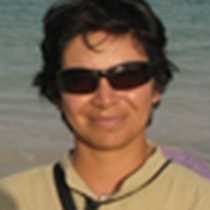Bartolomé and Santiago Islands
We are just starting our week in the Galápagos Islands; this will be an amazing week because we happen to be in the middle of the warm, wet season. This translates into breeding behaviors and a lot of foraging activities for the animals that inhabit this wonderful paradise.
Our day began with an early pre-breakfast outing to visit Bartolomé Island. As we started our hike to the top, we realized that we were on an extinct cinder cone; animals like lava lizards were just starting to warm up and could be spotted easily along the way. Pioneer plants were growing on top of the little available soil found between the cracks of the volcanic formations. Once at the top, one of the most incredible landscapes was observed. Perhaps one of the most famous views would be “pinnacle rock” and the two golden-sand bays, both bathed by warm waters.
After climbing to the top of Bartolomé, we returned aboard for a well deserved breakfast. This was followed with a snorkeling gear fitting session. Once we were all geared up, we went ashore once more, this time to explore the submarine world. While snorkeling, we encountered several species of fish and also found a white-tipped reef shark.
For the afternoon, we sailed towards Santiago Island. This used to be a popular place among pirates and whalers because of the presence of giant tortoises. This area provided them with food, and the hills nearby had small water springs, which completed the deal.
While exploring the coastal zone of this area and found Galápagos sea lions, marine iguanas and Galápagos fur seals. As we walked along the coast, we were greatly surprised by the presence of a pod of bottle nosed dolphins. These dolphins gave us a great show, as some were jumping up high in the air. A little further away from the coast, we spotted a couple of large spouts. This was later identified to be a Bryde’s Whale; this kind of whale can be observed all year around in the waters of the archipelago.
After a great day, we returned on board to begin our sailing to Santa Cruz Island.
We are just starting our week in the Galápagos Islands; this will be an amazing week because we happen to be in the middle of the warm, wet season. This translates into breeding behaviors and a lot of foraging activities for the animals that inhabit this wonderful paradise.
Our day began with an early pre-breakfast outing to visit Bartolomé Island. As we started our hike to the top, we realized that we were on an extinct cinder cone; animals like lava lizards were just starting to warm up and could be spotted easily along the way. Pioneer plants were growing on top of the little available soil found between the cracks of the volcanic formations. Once at the top, one of the most incredible landscapes was observed. Perhaps one of the most famous views would be “pinnacle rock” and the two golden-sand bays, both bathed by warm waters.
After climbing to the top of Bartolomé, we returned aboard for a well deserved breakfast. This was followed with a snorkeling gear fitting session. Once we were all geared up, we went ashore once more, this time to explore the submarine world. While snorkeling, we encountered several species of fish and also found a white-tipped reef shark.
For the afternoon, we sailed towards Santiago Island. This used to be a popular place among pirates and whalers because of the presence of giant tortoises. This area provided them with food, and the hills nearby had small water springs, which completed the deal.
While exploring the coastal zone of this area and found Galápagos sea lions, marine iguanas and Galápagos fur seals. As we walked along the coast, we were greatly surprised by the presence of a pod of bottle nosed dolphins. These dolphins gave us a great show, as some were jumping up high in the air. A little further away from the coast, we spotted a couple of large spouts. This was later identified to be a Bryde’s Whale; this kind of whale can be observed all year around in the waters of the archipelago.
After a great day, we returned on board to begin our sailing to Santa Cruz Island.




